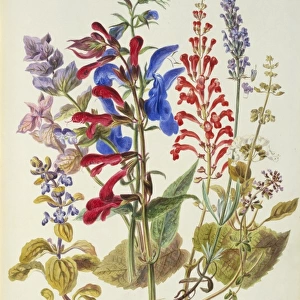Mouse Mat : Convolvulaceae
![]()

Home Decor from Mary Evans Picture Library
Convolvulaceae
Plate 116 from The Chief Natural Orders of Plants (1849). Illustrated and described by Elizabeth Twining (1805-1889)
Mary Evans Picture Library makes available wonderful images created for people to enjoy over the centuries
Media ID 8590307
© Mary Evans Picture Library 2015 - https://copyrighthub.org/s0/hub1/creation/maryevans/MaryEvansPictureID/10708172
1805 1889 Asterid Bind Weed Bindweed Convolvulaceae Convolvulus Elizabeth Twining Eudicot Solanales Twining Angiospermae Dicot Dicotyledon Magnoliophyta
Mouse Pad
Standard Size Mouse Pad 7.75" x 9..25". High density Neoprene w linen surface. Easy to clean, stain resistant finish. Rounded corners.
Archive quality photographic print in a durable wipe clean mouse mat with non slip backing. Works with all computer mice
Estimated Image Size (if not cropped) is 18.9cm x 23.7cm (7.4" x 9.3")
Estimated Product Size is 20.2cm x 23.7cm (8" x 9.3")
These are individually made so all sizes are approximate
Artwork printed orientated as per the preview above, with portrait (vertical) orientation to match the source image.
EDITORS COMMENTS
Plate 116 from The Chief Natural Orders of Plants, an exquisite Victorian-era botanical illustration by Elizabeth Twining (1805-1889) showcases the stunning beauty of a Convolvulaceae flower, specifically the Convolvulus species. Dating back to the 19th century, this illustration is a testament to the intricate detail and artistic skill of the time. The flower, with its vibrant blue hue, is depicted in full bloom, its petals delicately unfurled to reveal their intricate texture and veining. The Convolvulaceae, commonly known as the bindweeds, are a diverse family of flowering plants, belonging to the order Solanales and the class Magnoliophyta. They are angiosperms, meaning they produce seeds enclosed in an ovary, and are dicotyledons, characterized by having two seed leaves. This particular illustration showcases the eudicotyledonous nature of the Convolvulaceae, as evidenced by the net-like venation pattern visible in the leaves. The Convolvulaceae are known for their twining stems, which allow them to climb and support themselves, making them a common sight in gardens and natural habitats alike. The family is part of the asterid clade, a large and diverse group of flowering plants, and is a valuable source of research in areas such as genetics and pharmacology. Elizabeth Twining was a prolific botanical illustrator of her time, producing numerous works that documented the natural world with great accuracy and artistry. Her illustrations, such as this one, continue to captivate and inspire, offering a glimpse into the rich biodiversity of the Victorian era and beyond.
MADE IN THE USA
Safe Shipping with 30 Day Money Back Guarantee
FREE PERSONALISATION*
We are proud to offer a range of customisation features including Personalised Captions, Color Filters and Picture Zoom Tools
SECURE PAYMENTS
We happily accept a wide range of payment options so you can pay for the things you need in the way that is most convenient for you
* Options may vary by product and licensing agreement. Zoomed Pictures can be adjusted in the Cart.







